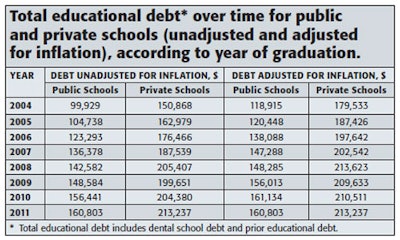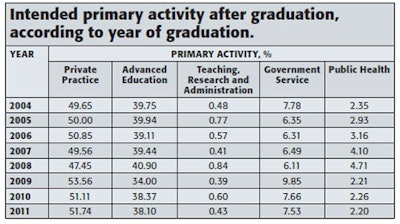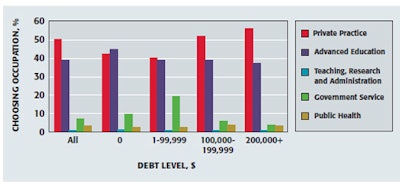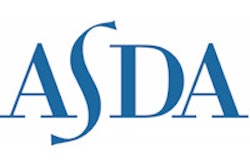
Despite concerns about dental graduates being saddled with huge school loans, factors such as race and ethnicity -- rather than educational debt -- have a greater influence on their job choices, according to ADA researchers. Their somewhat surprising conclusion is discussed in the May issue of the Journal of the American Dental Association (Vol. 145:5, pp. 428-4340).
Dental school students' debt levels are rising: The average educational debt of graduating dental school seniors, including both dental school debt and prior educational debt, rose from $122,000 in 2004 to $179,000 in 2011 according to data from the American Dental Education Association (ADEA).
However, dentists' income has not risen as rapidly over the same period. As a result, average educational debt rose from 70% of dentists' median income in 1996 to 103% of dentists' median income in 2011, the researchers note.
“These results run counter to the conventional wisdom that rising educational debt is a primary driver pushing students toward private practice.”
"This rise suggests an increase in the burden placed on dental school graduates," they wrote.
Additionally, rising debt relative to income may be exacerbated by an influx in new dental school graduates. The application to enrollment ratio reached a historical high of 2.9 applicants for each first-year dental school student spot in 2007 before easing slightly to 2.5 in 2008, but it remained well above the 1950-2008 average of 1.7, the study found.
And high demand for dental education has spurred the opening of 13 new planned or proposed dental schools.
"If the increased supply of dentists is not met with a comparable increase in demand for dental services, then the higher supply of dentists is expected to further limit wage gains and exacerbate the declining return to dental education," the researchers note.
Rising educational debt without a comparable increase in expected income has the potential to affect graduates' career choices -- including specialty training, willingness to work in underserved areas, and willingness to treat Medicaid patients -- as well as practice ownership options.
"The result is that educational debt may increase the likelihood of choosing private practice instead of government service; teaching, research, and administration; or public health positions," the study authors pointed out.
This study used the ADEA's survey of senior dental school students from 2004-2011, including 25,176 seniors whose average age was 28, with an average of $168,300 in school debt. The analysis included five intended job choices: private practice, advanced education, government service, public health, and teaching, research, and administration.
Adjusted for inflation, debt among students at public dental schools rose from an average of $118,915 in 2004 to $160,803 in 2011, and among students at private dental schools, debt increased from $179,533 in 2004 to $213,237 in 2011.
 All charts courtesy of the American Dental Association.
All charts courtesy of the American Dental Association.Results
Notably, from 2004 to 2011, the researchers did not see a trend in students intending to enter private practice. The percentage of students intending to work in private practice ranged from 47.45% in 2008 to 53.56% in 2009.
The intention to enter public health was not significantly correlated with educational debt, the researchers found. African-American dental students were approximately twice as likely to go into advanced education or government service compared with private practice as compared with white students. African-American dental students were also more than three times more likely to choose public health, the study found.

For a $10,000 increase in debt, there was a small increase in probability that a student would pursue private practice versus seeking advanced education; teaching, research, and administration; or a government service position, according to the study authors. Female students were more likely than male students to pursue teaching, research, and administration and public health positions over private practice, but they were less likely to choose government service positions.

Also, having a parent who's a dentist had an impact. Children of dentists were more likely to pursue private practice, perhaps taking over their parents' practice, the study authors found.
Once the study researchers took into account other characteristics, they found that the magnitude of the effect of educational debt on intended employment choice was relatively small.
"These results run counter to the conventional wisdom that rising educational debt is a primary driver pushing students toward private practice," the researchers noted.
Conclusion
"The results of our study show that student characteristics have a larger influence on intended employment choice than does total educational debt," the researchers concluded. "Despite educational debt receiving a lot attention, demographic enrollment trends appeared to be more important in determining the future dental labor market. Our findings suggest that focusing on the characteristics of the student body may be a better avenue for understanding employment after graduation."



















